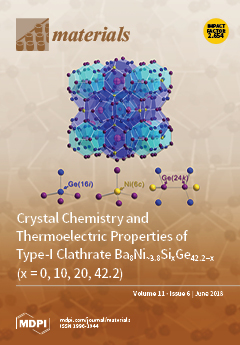Open AccessArticle
Characterization and Microstructure of Linear Electrode-Electrospun Graphene-Filled Polyvinyl Alcohol Nanofiber Films
by
Ting-Ting Li 1,2, Mengxue Yan 1, Qian Jiang 1, Hao-Kai Peng 1, Jia-Horng Lin 1,3,4,5,6,7 and Ching-Wen Lou 2,4,7,8,*
1
Innovation Platform of Intelligent and Energy-Saving Textiles, Tianjin Polytechnic University, Tianjin 300387, China
2
Fujian Key Laboratory of Novel Functional Fibers and Materials, Minjiang University, Fuzhou 350108, China
3
Laboratory of Fiber Application and Manufacturing, Department of Fiber and Composite Materials, Feng Chia University, Taichung 40724, Taiwan
4
Department of Chemical Engineering and Materials, Ocean College, Minjiang University, Fuzhou 350108, China
5
Department of Fashion Design, Asia University, Taichung 41354, Taiwan
6
School of Chinese Medicine, China Medical University, Taichung 40402, Taiwan
7
College of Textile and Clothing, Qingdao University, Shandong 266071, China
8
Department of Bioinformatics and Medical Engineering, Asia University, Taichung 41354, Taiwan
Cited by 10 | Viewed by 3629
Abstract
With the aim of achieving controllable mass production of electrospun nanofiber films, this study proposes and investigates the feasibility of using a custom-made linear electrode- electrospun device to produce conductive graphene (GR)-filled polyvinyl alcohol (PVA) nanofibers. The film morphology and diameter of nanofibers
[...] Read more.
With the aim of achieving controllable mass production of electrospun nanofiber films, this study proposes and investigates the feasibility of using a custom-made linear electrode- electrospun device to produce conductive graphene (GR)-filled polyvinyl alcohol (PVA) nanofibers. The film morphology and diameter of nanofibers are observed and measured to examine the effects of viscosity and conductivity of the PVA/GR mixtures. Likewise, the influence of the content of graphene on the hydrophilicity, electrical conductivity, electromagnetic interference shielding effectiveness (EMSE), and thermal stability of the PVA/GR nanofiber films is investigated. The test results show that the PVA/GR mixture has greater viscosity and electric conductivity than pure PVA solution and can be electrospun into PVA/GR nanofiber films that have good morphology and diameter distribution. The diameter of the nanofibers is 100 nm and the yield is 2.24 g/h, suggesting that the process qualifies for use in large-scale production. Increasing the content of graphene yields finer nanofibers, a smaller surface contact angle, and higher hydrophilicity of the nanofiber films. The presence of graphene is proven to improve the thermal stability and strengthens the EMSE by 20 dB at 150–1500 MHz. Mass production is proven to be feasible by the test results showing that PVA/GR nanofiber films can be used in the medical hygiene field.
Full article
►▼
Show Figures






